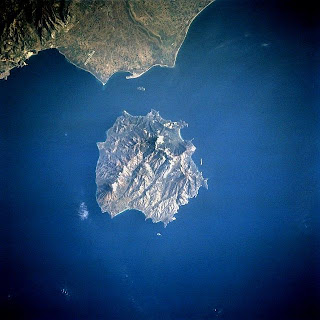All about Thassos

"The emerald green island of North Aegean Sea.A cosmopolitan island holding a wealth of history. Holidays on Thassos are an unforgettable experience."
Thasos, the northernmost of the islands of the Aegean Sea, is of volcanic origin, mountainous, and of great natural beauty. Situated close by the mainland, its nearest point is 10km from the mouth of the Nestos, and it thus faces the boundary between Macedonia and Thrace. The population of ca. 18,000 is distributed between the capital Limenas and ten other villages, of which the most modern is Limenaria, on the SW coast, where zinc workings are exploited. In the coastal areas tobacco and olives are cultivated. A road encircles the island: otherwise the only means of communication is by mule track. There is good water in the island. The marble quarries of Thasos have always been famous; the gold mines earned in antiquity for the island the epithet of 'golden'. Minerals worked today include silver, antimony, and zinc.
From Limenas, an asphalt road leads in 35 minutes past a classical cemetary to Makri Ammos, a pleasant beach with several tavernas.
The delightful inland villages can be easily reached. The road rises through pine-woods, and, crossing a ridge, emerges on a ledge (with a view of the beautiful Bay of Potamia). 5km Panayia has a square with two gushing fountains, shaded by plane-trees. 6.5km Potamia, slightly larger, with steep stone streets and old Turkish houses, is a starting-point for the ascent of Mt Hypsarion (1142m) in 2-3 hours.
The road, now part of the island round (92km), continues down the E coast. The island abounds in unexcavated Hellenic and medieval remains. On Cape Pirgos, in the NE, are some remains of an ancient lighthouse inscribed as his own tomb and memorial by one Akeratos. Vestiges of ancient Koinyra may be found farther S. At Aliki are ancient marble quarries, an Archaic sanctuary and two excavated basilican churches. The best preserved of many Hellenic towers is near Thimonia, the greatest concentration of them near Astris; they were probably for defence against pirates. Beyond Astris the road passes the Theologos turn before reaching (54km) Limenaria, a centre (ca. 2,000 inhab.) of cadmium mining. Theologos, in the Dipotamos valley below the S slope of Hypsarion, was the medieval capital. In Theologos there is the house of Mehmet Ali's youth survives and remains of a castle (Koufokastro) crown a hill to the SE. From Limenaria the road follows the W coast passing many small pensions and camping places amid the pines. Ormos Prinou, incorrectly but more usually called Prino, is ca. 16km short of Limenas (by bus).
The highest elevation of Thasos is the Ypsario, at 1,204 m. The main agricultural production on the island are honey and olive oil as well as wine, sheep, goat herding and fishing. Other industries includes lumber and tourism. Mining industry including lead, zinc and marble especially in the Panagia area where one of the mountains near the Thracian Sea has a large marble quarry. A marble quarry in the south has been mined during the ancient times. By far the most important economic activity is tourism.

Comments